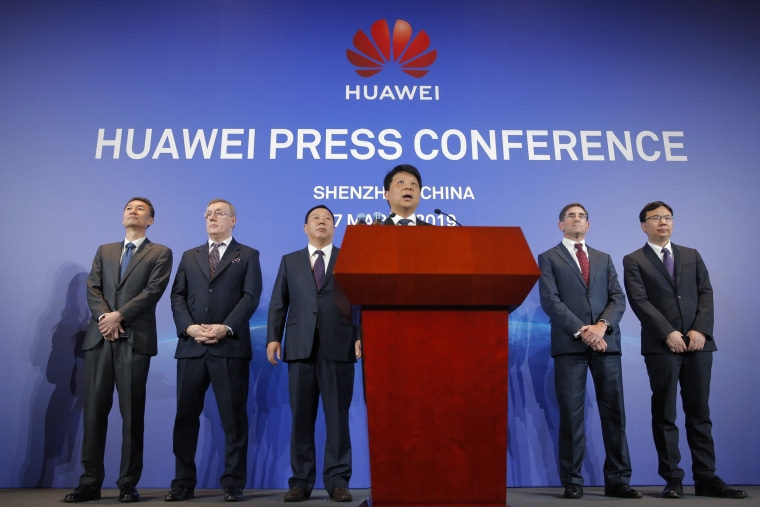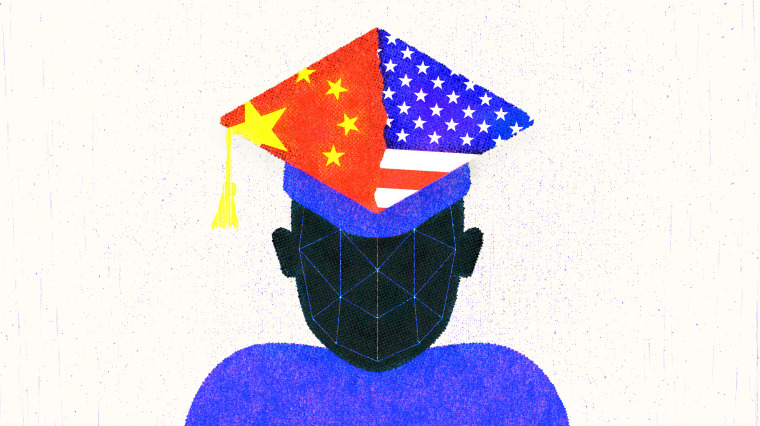The Trump administration’s efforts to isolate China’s technology development — culminating in its recent ban on Huawei — could derail next-generation technologies and fragment what has become an increasingly global digital community, according to national security and technology experts.
That could mean the end of global software that has allowed for free cross-ocean communication. It could cut off travelers who have grown accustomed to being able to jump on wireless networks while abroad. And it could put new roadblocks in the way of shared development of artificial intelligence technologies.
U.S. and Chinese tech companies have managed to coexist peacefully over the past two decades, elbowing each other for market share and fighting over intellectual property while also benefiting from their strengths.
That dynamic may be about to shatter. Concern is rising that closing off China will leave the United States at a disadvantage in the deployment of highly anticipated 5G wireless technology. American tech companies, including Apple, could become a target of Chinese retaliation. And new restrictions on exports, investment and immigration could throw cold water on hot areas of research, including artificial intelligence.
The U.S. “needs to think deeply about the second- or third-order of consequences that will play out over the next five to 10 years," said Jim Baker, former FBI general counsel and the director of national security and cybersecurity at the R Street Institute, a conservative think tank.
The Trump administration’s efforts do have some support among cybersecurity and national security experts. Critics of China point to the country’s willingness to execute cyberattacks and use AI-powered tech, including facial recognition, to entrench its grip on its ethnic minorities.
But creating a near-complete split between the tech industries in China and the U.S. is unlikely to reduce China’s abuse of technology.
“We should be clear-eyed about what is going on in China, especially with regard to human rights abuses, but we should not be hysterical about the level of security threat that China poses,” said Helen Toner, director of strategy at Georgetown University’s Center for Security and Emerging Technology.
“If the U.S. can act wisely and place its values front and center, it’s likely we can reach a new equilibrium that serves our interests,” Toner said. “Fear and hype tend to damage the U.S. rather than serve it.”
Who can build 5G?
U.S. businesses that want to work with Huawei, the world’s largest supplier of telecommunications equipment, will need to obtain a hard-to-get license under Trump administration restrictions that are set to begin in about 90 days.
The effects have quickly rippled through the worldwide tech industry, as companies from Google to Intel to Japanese telecom providers have backed off their relationship with Huawei, at least in the near term.
One consequence of the action: The U.S. and any other country that spurns Huawei will need to figure out precisely how they’ll deploy 5G technology without the Chinese company. Development of 5G is considered vital to the communications of the future because, boosters say, it will mean more than just a faster mobile experience. They say it will form the foundation of a whole new set of products, enabling the deployment of self-driving car fleets, more robotics in the home or even partially automated surgeries.
While China may accelerate its 5G ambitions and possibly retaliate against U.S. companies, a lot of pressure is falling on Huawei’s few rivals to fill a void in the rest of the market.
“We're entering a very precarious time," said Naomi Wilson, the senior director of policy for Asia at the Information Technology Industry Council, a trade association. "[The U.S.] should do all it can to avoid giving the Chinese an excuse to retaliate against U.S. companies."
There are only a handful of manufacturers in the world that are truly capable of creating top-tier 5G wireless networks. But Huawei is already ahead of its rivals in being able to actually implement the technology. If the other companies, which include Nokia and Ericsson, fail to keep pace, U.S. network providers such as AT&T, Verizon and T-Mobile may not have access to the best 5G, experts said.

The central role that 5G is expected to play in future technologies also makes it particularly sensitive. The U.S. intelligence community has said that Huawei's control of 5G networks would give Beijing the ability to spy on U.S. citizens and threaten American infrastructure, an allegation that Huawei has denied.
“Huawei's products are ultimately commodities,” Huawei CEO Ren Zhengfei told Chinese media this week, according to a company transcript. “People use them if they like them. Politics should be left out of it. Huawei is just a company.”
The issue is personal for Zhengfei. His daughter, the company’s CFO, was detained in Canada last year at the request of U.S. prosecutors, and she awaits further extradition proceedings.
It’s unclear if or how China might retaliate against the U.S. export restrictions. On Wednesday, Goldman Sachs warned that Apple’s earnings could fall by 29 percent if its products were banned in China. Experts said that other U.S. vulnerabilities include minerals and other natural resources, owned by China, that are needed to create hardware.
The alleged benefit to Americans of walling off Huawei — higher security against alleged Chinese spying — isn’t foolproof, either. The U.S. will not be able to stop Americans from sharing data on Huawei networks when they travel abroad or correspond with people in other countries.
Still, the addition of Huawei to the Department of Commerce’s banned “entity list” is a move the Trump administration could replicate for other Chinese firms that it deems should not have access to U.S. technology. Officials are already considering adding five Chinese video surveillance companies to the list, including Megvii and Hikvision, Bloomberg News reported.
The Trump administration has other tools it can use besides export controls. Last year, Trump signed legislation expanding the government’s ability to block foreign investments in American companies, and in the months afterward, Chinese venture funding in U.S. startups slowed to a trickle, Reuters reported.
Can code be contained?
The fallout may spread to cutting-edge areas of technology that rely on the free flow of information among far-flung researchers on different continents, with artificial intelligence as a prime example.
The U.S. and China have been in what some call an “arms race” to be the world leader in AI and machine learning, the technologies that are increasingly put to use in fields as diverse as banking, health care and the military to make computer systems more efficient and displace some jobs done by humans.
“I think that the Cold War in military and commercial AI has already begun,” said Oren Etzioni, CEO of the Allen Institute for Artificial Intelligence, a Seattle nonprofit that conducts AI research.
However, he added, “academic publications are still open and international and will hopefully remain that way.”
The U.S. sector, bolstered by Silicon Valley tech firms, has a sizable head start on AI, but China two years ago announced a plan to try to overtake the lead by 2030, with the help of large investments from its government, access to data about more than 1 billion people and a willingness to use AI for things like facial recognition that human rights advocates find questionable.
President Donald Trump in February issued an executive order laying out a playbook of his own with ways to encourage further development of the technology, including opening access to federal data and pushing federal agencies to prioritize research and development into how they can use AI.
But there are signs the Trump administration could become more aggressive in restricting the export of AI technology. In November, the Commerce Department included various forms of artificial intelligence and machine learning on a list of emerging technologies it was considering for tighter controls.
The immediate purpose of the list was to receive public feedback, but new regulations could follow, the department said. The administration could, for example, ban the export of certain types of algorithms or machine-learning techniques, especially if they have a potential application for the military.
Elsewhere in the U.S. government, the Department of Defense has closely watched China’s pursuit of AI tech. Last year, the Defense Innovation Unit Experimental, an arm of the Pentagon in Silicon Valley, said in a report that China had “flooded” the U.S. tech sector with cash in an attempt to “access the crown jewels of U.S. innovation.”
The report suggested an overhaul of how the U.S. government thinks about controlling the export of technology, a process that the report said was outdated because it was based on the ability to clearly distinguish military technology from commercial tech.
But it acknowledged that industry isn’t generally on board with tougher regulations.
“Controlling a broad technology will be highly controversial within the venture and technology community where the largest markets are for benign, commercial purposes,” the report said.
Although much of the basic research of artificial intelligence is open-source — meaning that the computer code or the intellectual property behind it are free for anyone to use without worrying about patents — the actual software products and apps that get built may not be, and they could face trade restrictions or practical barriers across international borders.
The era of tech companies attempting to be truly global, serving customers anywhere, may soon be coming to a close, Sunny Kumar, a partner at venture capital firm GSR Ventures, said.
“The bigger picture question is whether there’s going to be a set of global platforms, or if you’re going to have a set of more regionally focused platforms,” Kumar said. “At a macro level, what this is likely going to push us towards is where we get to two if not more tech ecosystems.”
It’s not that different, he added, from the way things were before the rise of the internet, when industries such as automakers, entertainment and dining were all regional and the thought of a global player was unrealistic.
There are attempts to knit together the communities of software engineers and researchers across borders. In October, search engine Baidu became the first Chinese company to join the Partnership on AI, a San Francisco-based nonprofit that serves as a meeting point for researchers, civil society and others interested in AI.
The Partnership on AI said it planned to add more members from China, while Baidu President Ya-Qin Zhang said it was “looking forward to both sharing our own insights and learning from our international peers.”

